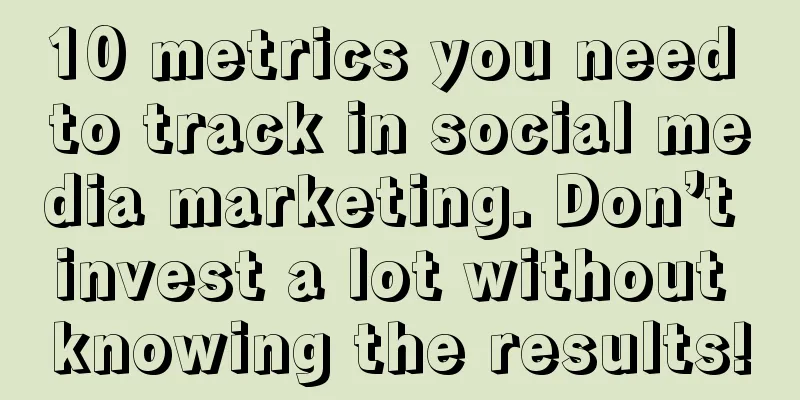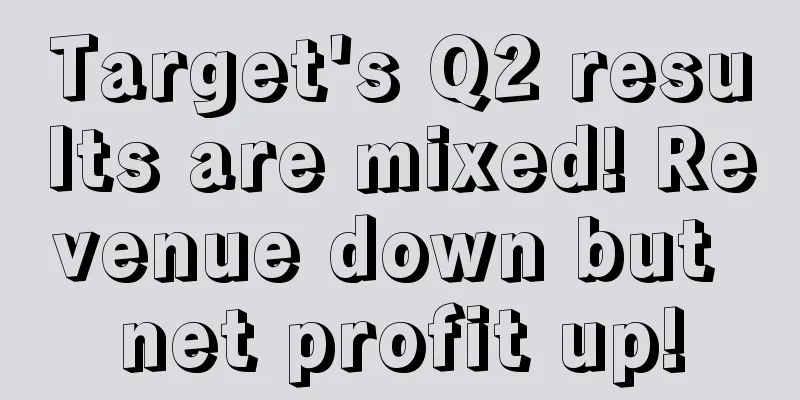10 metrics you need to track in social media marketing. Don’t invest a lot without knowing the results!

|
Sellers, have you invested a lot of time, money and energy in social media marketing but don't know how effective it is? It's time to understand the social media marketing performance indicators and make relevant reports to understand how much return you have received for your efforts. This article will explain the 10 indicators that e-commerce sellers need to track in social media marketing to create social media marketing effectiveness reports. Create a spreadsheet to track key social media metrics Before you dive into the social media marketing metrics you need to track, create a new Google or Excel spreadsheet to better track your data. Once you create the table, you can add the metrics you want to track in the corresponding rows and columns. Here is an example of a spreadsheet: Let’s take a look at 10 metrics that marketers should track in their social media marketing to help you evaluate your social media marketing effectiveness.
1. Content Metrics By tracking content metrics, you can analyze the content shared on social media and discover certain content patterns, perhaps you find that 75% of your posts are image-based and only 25% are video-based, and you can quickly see the breakdown of original content shared vs. content created by others. Original content from others includes articles written by industry experts (you should credit the source in your posts) or posts that you repost after an influencer shares your product. A variety of other content can also fall into this category, including testimonials, reviews, user-generated posts, publications, and industry infographics. Sharing this type of content can help you capture the attention of potential users, demonstrate your expertise, and create a positive impact on your brand. In the content metrics, you can see if you have added the following to increase the richness of your social media homepage: Link posts; Video posts; Picture post; Text-based posts; Original content; Other content. To collect this data, go to your social accounts and see what type of content you primarily post. You can also use tools like BuzzSumo and Agorapulse to automatically generate data on the amount and type of content you share. 2. Time Indicator When do you post on social media? When do your audiences engage with your content the most? Are you consistent in your postings? Are your posts timely and relevant to your audience? Tracking time metrics will help you determine the best time to post content and help you identify gaps that need to be filled. For example, when to start leveraging fashion and related topics, or posting at different times of the day. You can track the following time metrics: Number of posts per week; Most common posting times The most common release date; Timeliness/seasonality of posts The time period when audience engagement is highest; The dates with the most engagement from your audience. With these metrics, you can see the times and days you post, how often you post, and view time metrics for your audience across your social media accounts. There are also a lot of industry studies out there that can help you determine the best days and times to post relevant to a specific industry. For example, Sprout Social’s research suggests the best days and times to post for businesses in the healthcare industry. 3. Audience Metrics Tracking audience metrics helps you determine if your target audience is engaging with your content. If your customers are primarily men aged 45-55 living in Seattle, but 90% of your Instagram followers are women aged 20-50 from around the world, then you have an audience misalignment problem. You’re attracting the wrong people with your social media content. Bots can also be a problem. They don’t do anything for you other than temporarily boost your like count or engagement, and using bots can do more harm than good. When a social media platform detects a high number of bot interactions with your account, it may penalize you for it. Tracking your audience data helps ensure you have real fans and audiences who want to engage with your content, covering the following areas: Total number of fans; Number of new followers New accounts you follow The percentage of male fans; The percentage of female fans Main age groups; The main location; · Google Analytics sync analysis. Here are some tools you can use to analyze your social media audience: ·Friends+Me (Facebook, LinkedIn, Twitter, Pinterest); ·Followerwonk (Twitter); Tailwind (Instagram and Pinterest) Social media insights (gender and location data); Google Analytics Audience Reports > Gender and Location Information. Google Analytics is included in this list because your social media audience should match the users who visit and convert on your website. *Remember: know your audience, track their behavior, and make sure the customers you’re trying to target are the same ones who interact with you online.
4. Listen to indicators With social media listening, you’re not just tracking mentions, you’re also gaining insight into how people are commenting and discussing your brand on social media and measuring the sentiment of those comments (positive, neutral, or negative). By monitoring and analyzing conversations, you can determine how to respond on behalf of your brand, solving customers’ problems or offering thanks and praise when needed. Tracking social media listening metrics involves the following aspects: Mentions of the brand The number of comments with positive sentiment; The number of comments with negative sentiment; The number of comments with neutral sentiment; Main mentioners. Here are some of the best tools for tracking brand mentions on social media: ·Mention; TweetDeck Brandwatch; SEMrush. You can also try to manually follow the conversation by following branded hashtags and @mentions, but keep in mind that not every user includes that information in their posts.
5. Competitor indicators Understanding what your competitors are doing on social media can be beneficial to your own social media marketing. But don’t try to apply the methods used by your competitors to your own business. Instead, use the information you gather from your research to come up with new ideas and strategies and try to implement them. When tracking competitor metrics, there are a few areas to consider: Competitors’ strengths; Competitors’ weaknesses; New opportunities Difference in participation (percentage). To check out your competitors on social media, go to your competitor profile and look at their posts and ads from your perspective. Pay attention to the type of content they share and whether they use any advanced strategies, such as working with specific influencers. Tools like Likealyzer, Phlanx, SEMrush, and BuzzSumo can help you gain a deeper understanding of your competitors. 6. Engagement Metrics Typically, engagement metrics are the primary metric by which businesses judge the effectiveness of their social media marketing campaigns. However, unless your specific goal is to increase the number of likes, engagement metrics only measure the overall picture. To fully understand engagement, you need to track: Total engagement Individual engagement by type (retweets, likes, comments, link clicks, shares, etc.); · Percentage increase/decrease in participation rate; Number of mentions received; The number of messages received. You can find engagement metrics and calculate data in the insights of the social media homepage background, but it is not recommended for marketers to calculate data manually because it is too time-consuming. You can check social media tools such as Hootsuite, Sprout Social or Agorapulse, which will make collecting data easier. 7. Social Media Traffic Metrics Is social media one of your top traffic drivers? What is your bounce rate for social media visitors? For example, are visitors leaving your site immediately and returning to Facebook? If so, your social media messaging may not align with your website content and you need to make some adjustments. Your ultimate goal is to get social users to take action, and conversions often have a big impact on your website titles, product pages, and collecting customer information. You want to track what happens when social users click on a link post and visit your website. Does the visitor fill out your form or click through multiple pages on your website? Analyzing this data can inform your approach to social media link posts. To monitor social traffic metrics, you need to know the following: Total number of browsing users; Total page views Bounce rate How many pages each user viewed (Pages Per Session); Average session duration Mobile and desktop traffic (e.g. m.Facebook) Most shared links on social media. A variety of tools will provide social media traffic data, including: Google Analytics; SEMrush Ahrefs.
8. Brand indicators Brand metrics are designed to measure how well your social posts match your brand. Is your branding clear across posts? Do the images you share on your social channels use the same filter or have a similar feel? Do you use the correct brand name in your posts? All brands should have a brand guide PDF that outlines important brand specifications such as: Terminology to avoid; Company name (capital and abbreviation); A mission or statement to follow; Visual merchandising guidelines; Public relations policy; Basic dos and don’ts. The brand data that marketers need to track mainly include the following: Do all posts comply with brand guidelines? Y/N; ·Are there any changes in branding? Y / N; Does the post reflect the change? Y/N. You need to evaluate your brand on social media to ensure that your social media posts are in compliance with brand guidelines. If you find that your January posts use the abbreviation of your company name and your February posts use the full brand name, then you need to resolve this name inconsistency. Find a comfortable rhythm for branding your social content and stick to it. Users will notice and start switching over to your brand style.
9. Social Media Management Metrics Social media management metrics are data indicators that marketers often forget to measure, mainly the following: Who manages your social media? How many people are on your social team? How often are reports produced? Who is responsible for or reporting the results? Any correlation between team size and achieving goals? What is the average response time? What is the average response time for DMs or messages? What public relations problems have arisen, and who will resolve them? You don’t need a specific tool to track this data. Feel free to expand on your answers to the questions above to ensure you have comprehensive coverage of relevant metrics. Tracking this information will help you identify factors in social media management that impact your marketing efforts and how successfully you’re reaching your goals. 10. Goals and summary indicators Goals and summary metrics are the last and most important data to measure in your report. Does any of the data you collected above align with your goals for Instagram, Facebook, LinkedIn, or Pinterest? Make sure you know what your goals are and how you’re going to achieve them. For example, instead of setting a goal to increase Instagram engagement from March to April, you might set a goal to receive at least 150 engagements on each Instagram post, posting once a day for 30 days. Once you’ve set your goals, look at the data and see what you’ve accomplished. When tracking your goals, there are a few things to consider: ·Have you achieved your main goals? Y / N; ·Have you achieved your secondary goals? Y / N; ·Percentage difference between the previous quarter and the current quarter. The summary indicators mainly involve: Conversion rate; The number of completed conversions; · Economic value gain/loss; Overall social media reach; The number of overall social media posts on the topic. If you’ve hit your primary and secondary goals and have plenty of data to prove it, you’re ready to create new goals on social media and up the ante. If you didn’t hit your primary or secondary goals, think about what conclusions you’ve drawn. Maybe Pinterest isn’t meeting your overall goals and it’s time to abandon your marketing campaigns on the platform. Or maybe you’ve found that your image posts are no longer performing well and it’s better to focus on producing video content. in conclusion Social media marketing effectiveness measurement is more than just focusing on engagement and reach. You also need to examine all of your social media marketing efforts, as well as analyze your strategy and the competition. It is recommended that you review your social media marketing metrics on a quarterly basis. This will ensure that you have enough useful data to make important decisions. Additionally, as you move into the next quarter, this data will allow you to make any necessary adjustments to your social media marketing. Text ✎ Mary/ Statement: When reprinting this article, the title and original text must not be modified, and the source and original link must be retained. |
<<: How to run Facebook ads for Amazon products?
>>: Competitor Research: How to Monitor Your Competitors’ Facebook and Instagram Ads
Recommend
What are the key points of Amazon boutique operation?
The key to successfully running an Amazon store li...
What is Haixianhui? Haixianhui Review
Yiwu Haixianhui Information Technology Co., Ltd. (...
Insights into US retail industry trends! Here are the hot spots for consumption in the second half of the year
Rising inflation, falling consumer demand and fall...
Amazon's store closures continue! Where is the safe way out for sellers?
Recently, there have been news reports that the s...
More than 3 million steam cleaners are urgently recalled! Available on Amazon and other platforms
It is learned that the U.S. Consumer Product Safet...
Amazon released several favorable policies! Sellers' profits increased significantly and there are free services?
In the past two days, Amazon has released a numbe...
What is TuSimple? TuSimple Review
TuSimple is a company that develops autonomous dri...
Too much! The big seller's overseas warehouse sold 20 million, and the small seller became a service provider to subsidize Amazon...
In March, the temperature gradually rises in many ...
In preparation for the peak season, there are new changes in cross-border logistics, platforms and taxation!
With the rise of the "Four Little Dragons&qu...
What is Sell to Africa? Sell to Africa Review
Sell to Africa is a building materials e-commerc...
What is CICPA? CICPA Review
CICPA is the abbreviation of Certified Public Acco...
51% of American consumers will shop online early next year! Strong demand for electronic products!
<span data-shimo-docs="[[20,"获悉,根据物流运输公司Pi...
What is Amazon Global Selling? Amazon Global Selling Review
Global Selling is a project launched by Amazon to ...
What is mountaintea? Mountaintea review
Mountaintea is a grower, manufacturer and merchant...
Sales volume exceeds 160,000! Domestic children's water cups are urgently recalled!
<span data-shimo-docs="[[20,"获悉,据外媒报道,近日美国...









